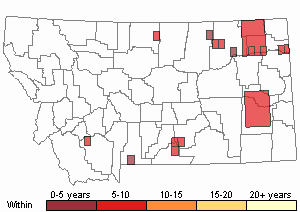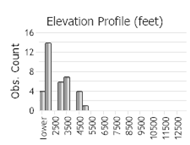View in other NatureServe Network Field Guides
NatureServe
Montana
Utah
Wyoming
Idaho
Wisconsin
British Columbia
South Carolina
Yukon
California
New York
American Common Reed - Phragmites australis ssp. americanus
Other Names:
Common Reed
Native Species
Global Rank:
G5T5
State Rank:
S4
(see State Rank Reason below)
C-value:
3
Agency Status
USFWS:
USFS:
BLM:
External Links
State Rank Reason (see State Rank above)
Phragmites australis subspecies americanus is native in Canada and the USA (Flora of North America 2007). In Montana, plants are found in scattered occurrences in many counties in the western, central, and northeastern portions of the state. On the landscape, populations are small, nearly monotypic but intermixed with other plant communities, and appear to expand very slowly. Montana’s populations of Phragmites australis subspecies americanus are considered stable.
The Montana Natural Heritage Program tracks Phragmites australis at the subspecies (subsp.) level because subsp. americanus is native while subsp. australis is introduced in the state. In reporting information on Phragmites australis, it is important to identify plants at the subspecies level in order to facilitate accurate identifications, data collecting, and appropriate management actions.
General Description
PLANTS: A cool season, rhizomatous perennial grass. Stems are stout, erect, and hollow, forming dense, tall stands of 1.5-3.5 meters tall. Sources: Gucker 2008; Lesica et al. 2022
LEAVES: Blades are flat, 315-40 cm long, and 2–4 cm wide, flat and lax to ascending. Sheaths have overlapping margins. Ligules are hairy, 3–6 mm long. Auricles are lacking. Sources: Giblin et al. [eds.] 2018; Lesica et al. 2022
INFLORESCENCE: A large feathery (plumose) panicle, 15–32 cm long, and often purplish. Spikelets, 11–14 mm long, with 3 to 8 florets. Rachilla with numerous long, silky hairs that cover the spikelets. Glumes are 1-3 nerved, rounded on the back; 2nd glume is longer than the 1st glume, but shorter than 1st lemma. Lemmas are 3-nerved, rounded on the back, hairless, and with an awn-like tip. Palea is well developed. Florets are the unit of dispersal, disarticulating above the glumes. Sources: Giblin et al. [eds.] 2018; Lesica et al. 2022
Subspecies americanus: Ligule usually 0.2-1.0 mm long. 1st (lower) Glume 4.0-6.5 mm long. 2nd (upper) Glume 7.5-11 mm long. Sources: Michigan State University Extension no date; Giblin et al. [eds.] 2018; Lesica et al. 2022
Phenology
Across its range, flowers and fruits develop from July to November (Gucky 2008). American Common Reed tends to emerge later than European Common Reed (Gucky 2008).
Diagnostic Characteristics
American and European subspecies of
Phragmites australis can grow in patches adjacent to one another (MSUE no date).
They can be distinguished by examining the characteristics of the lower stem, ligules, and lemmas
across a given population (
not just from a few stems):
* Ligule: The membranous extension where the leaf sheath and leaf blade meet. On the middle leaves, measure the membranous portion, not the fringe of hairs.
* Glumes: At the base of each spikelet is a pair of bracts called glumes.
Subspecies americanus - American Common Reed, native and desirable
* Growth Form: Relatively less robust - typically reaching 6 feet. Stands often have space for other plants to colonize.
* Culms: Often Leaf sheaths fall prematurely with age (caducous). When exposed to sunlight the stem turns bright red to purplish. Stems stay shiny late into the growing season.
* Ligule: Membrane, 0.2 – 0.9 mm tall.
* Glumes: 1st (lowest) glume is shortest, (2.6)4-7 mm long; 2nd glume is longer, but shorter than the lemma.
* Lemma: 9.3-9.9 mm long.
Subspecies australis - European Common Reed,
not native and undesirable
* Growth Form: Robust – reaching up to 18 meters in places within the USA. Stands outcompete native plant species.
* Culms: Leaf sheaths cling tightly to the stem. Remove the lower leaf sheaths and find a yellow to yellow-brown stem that stays dull into the growing season.
* Ligule: Membrane, 0.1 – 0.4 mm tall.
* Glumes: 1st (lowest) glume is shortest, 2.6-4.8 mm long; 2nd glume is longer, but shorter than the lemma.
* Lemma: 6.4-8.7 mm long.
Range Comments
Phragmites australis subsp. americanus occurs from southern British Columbia in Canada to the United States of America (USA) (Giblin et al. [eds.] 2018). In the USA, plants are found on both sides of the Cascade Mountains south to California and east to Montana, Wyoming, and in scattered locations to the Atlantic coast (Giblin et al. [eds.] 2018).
Observations in Montana Natural Heritage Program Database
Number of Observations: 41
(Click on the following maps and charts to see full sized version)
Map Help and Descriptions
Relative Density

Recency



 (Observations spanning multiple months or years are excluded from time charts)
(Observations spanning multiple months or years are excluded from time charts)
Habitat
In Montana, American Common Reed is found at the margins of ponds, marshes, and river floodplains and in roadside ditches et al. (Lesica et al. 2022). Dense stands often form along large rivers, seeps, and wet meadows at low elevations (Lesica et al. 2022).
Ecology
Readers should also consult the species’ profile for Common Reed (
Phragmites australis).
PLANT COMPETITIONSeveral aspects of American Common Reed allow it to co-occur with other native plant species (MSUE no date). The stems are relatively less robust. Stands are often more open, allowing light to penetrate through the canopy for other plants to colonize. Stems break down easily over winter, allowing other plants to grow.
PLANT-ANIMAL INTERACTIONSGreenhouse experiments and field studies found that American Common Reed may be more susceptible to aphid infestations than European Common Reed (Gucker et al. 2008). Aphid feeding caused chlorosis, and even led to some deaths of American Common Reed.
Reproductive Characteristics
Plants reproduce by seed, and vegetatively by rhizomes.
Readers should also consult the species’ profile for Common Reed (
Phragmites australis).
PLANT BIOLOGYIn comparison to the European Common Reed, American Common Reed plants emerge later, produce less biomass, and activate less readily dormant rhizome buds. Where nutrient availability is high, American Common Reed will grow denser and taller (MSUE no date).
Economic Value
CULTURAL USESBroadly speaking, Common Reed was used by Native American peoples for foods, shelter, medicines, a great variety of tools, and spiritual practices (Gucker 2008). Colonists and settlers also used American Common Reed for foods, shelter, and tools of many kinds. For information and references about how specific Native American peoples, consult Gucker 2008. For additional information on cultural uses consult the species’ profile for Common Reed (
Phragmites australis).
Food and MedicinesThe seeds serve as a grain used in gruels, cereals, and breads (Kavasch 2005). The early shoots serve as a raw or cooked vegetable (Kavasch 2005). The roots and rhizomes provided year-round food, and were dug and roasted (Kavasch 2005). The stems serve as an excellent source of sugar (Kavasch 2005). Preparations of materials from Common Reed has been used to treat stomach, ear, and tooth pains, lung ailments, and diarrhea (Gucker 2008).
Shelter, Tools, & Other UsesCommon Reed is used in the construction of items used for food gathering, warfare, travel, relaxation, and spiritual practices (Gucker 2008). Items included fences, roofs (thatching), lattices, baskets, pipestems, arrow shafts, construction boards, mats and insulation, nets, prayer sticks, and erosion control (Allred
in FNA 2003; Kavasch 2005; Gucker 2008). Plants have been but are no longer used to make cigarettes and 'superior' pen quills (Allred
in FNA 2003). Plants are also used for fuel, fertilizer, and mulch (Gucker 2008). The large feathery panicles persist into winter and are valued for winter bouquets (Lesica et al. 2022).
Management
Readers should consult the species’ profile for Common Reed (
Phragmites australis).
RECLAMATIONThe native, American Common Reed has attributes (rhizomatous and dense growth form) that make can make it desirable in reclamation projects, such as for controlling erosion. It is imperative that only the certified, native American Common Reed from Montana populations be seeded or planted. American Common Reed has the ability to create small, nearly monoculture stands that occur in a matrix with other native plant communities; further, the stand creates enough openings to allow other plants to co-exist.
Stewardship Responsibility
Threats or Limiting Factors
Threats or negative impacts to Montana's populations of American Common Reed have not been identified. There is the potential for Montana's native populations to be outcompeted by the introduced European Common Reed; however, it is unknown if the two subspecies are co-occurring in Montana.
American Common Reed poses no negative or detrimental effects to native plants, native animals, and proper ecological functions.
References
- Literature Cited AboveLegend:
 View Online Publication
View Online Publication Flora of North America Editorial Committee, eds. 2007. Flora of North America North of Mexico. Volume 24. Magnoliophyta: Commelinidae, Part 1. Oxford University Press, Inc., NY. xxxiii + 911 pp.
Flora of North America Editorial Committee, eds. 2007. Flora of North America North of Mexico. Volume 24. Magnoliophyta: Commelinidae, Part 1. Oxford University Press, Inc., NY. xxxiii + 911 pp. Flora of North America Editorial Committee. 2003. Flora of North America North of Mexico. Vol. 25. Magnoliophyta: Commelinidae (in part): Poaceae, part 2. Oxford Univ. Press, New York. xxv + 781 pp.
Flora of North America Editorial Committee. 2003. Flora of North America North of Mexico. Vol. 25. Magnoliophyta: Commelinidae (in part): Poaceae, part 2. Oxford Univ. Press, New York. xxv + 781 pp. Gucker, Corey L. 2008. Fire Effects Information System (FEIS) for Phragmites australis. U.S. Department of Agriculture, Forest Service, Rocky Mountain Research Station, Fire Sciences Laboratory (Producer). [Accessed 23 March 2018]
Gucker, Corey L. 2008. Fire Effects Information System (FEIS) for Phragmites australis. U.S. Department of Agriculture, Forest Service, Rocky Mountain Research Station, Fire Sciences Laboratory (Producer). [Accessed 23 March 2018] Hitchcock, C.L. and A. Cronquist. 2018. Flora of the Pacific Northwest: An Illustrated Manual. Second Edition. Giblin, D.E., B.S. Legler, P.F. Zika, and R.G. Olmstead (eds). Seattle, WA: University of Washington Press in Association with Burke Museum of Natural History and Culture. 882 p.
Hitchcock, C.L. and A. Cronquist. 2018. Flora of the Pacific Northwest: An Illustrated Manual. Second Edition. Giblin, D.E., B.S. Legler, P.F. Zika, and R.G. Olmstead (eds). Seattle, WA: University of Washington Press in Association with Burke Museum of Natural History and Culture. 882 p. Lesica, P., M.T. Lavin, and P.F. Stickney. 2012. Manual of Montana Vascular Plants. Fort Worth, TX: BRIT Press. viii + 771 p.
Lesica, P., M.T. Lavin, and P.F. Stickney. 2012. Manual of Montana Vascular Plants. Fort Worth, TX: BRIT Press. viii + 771 p. Lesica, P., M.T. Lavin, and P.F. Stickney. 2022. Manual of Montana Vascular Plants, Second Edition. Fort Worth, TX: BRIT Press. viii + 779 p.
Lesica, P., M.T. Lavin, and P.F. Stickney. 2022. Manual of Montana Vascular Plants, Second Edition. Fort Worth, TX: BRIT Press. viii + 779 p. Michigan State University Extension. No Date. Phragmites australis identification pamphlet for subspecies. East Lansing, Michigan.
Michigan State University Extension. No Date. Phragmites australis identification pamphlet for subspecies. East Lansing, Michigan.
- Additional ReferencesLegend:
 View Online Publication
View Online Publication
Do you know of a citation we're missing? Hale, K.M. 2007. Investigations of the West Nile virus transmission cycle at Medicine Lake National Wildlife Refuge, Montana, 2005-2006. M.Sc. Thesis. Bozeman, MT: Montana State University. 74 p.
Hale, K.M. 2007. Investigations of the West Nile virus transmission cycle at Medicine Lake National Wildlife Refuge, Montana, 2005-2006. M.Sc. Thesis. Bozeman, MT: Montana State University. 74 p. Sater, S. 2022. The insects of Sevenmile Creek, a pictorial guide to their diversity and ecology. Undergraduate Thesis. Helena, MT: Carroll College. 242 p.
Sater, S. 2022. The insects of Sevenmile Creek, a pictorial guide to their diversity and ecology. Undergraduate Thesis. Helena, MT: Carroll College. 242 p.
- Web Search Engines for Articles on "American Common Reed"





